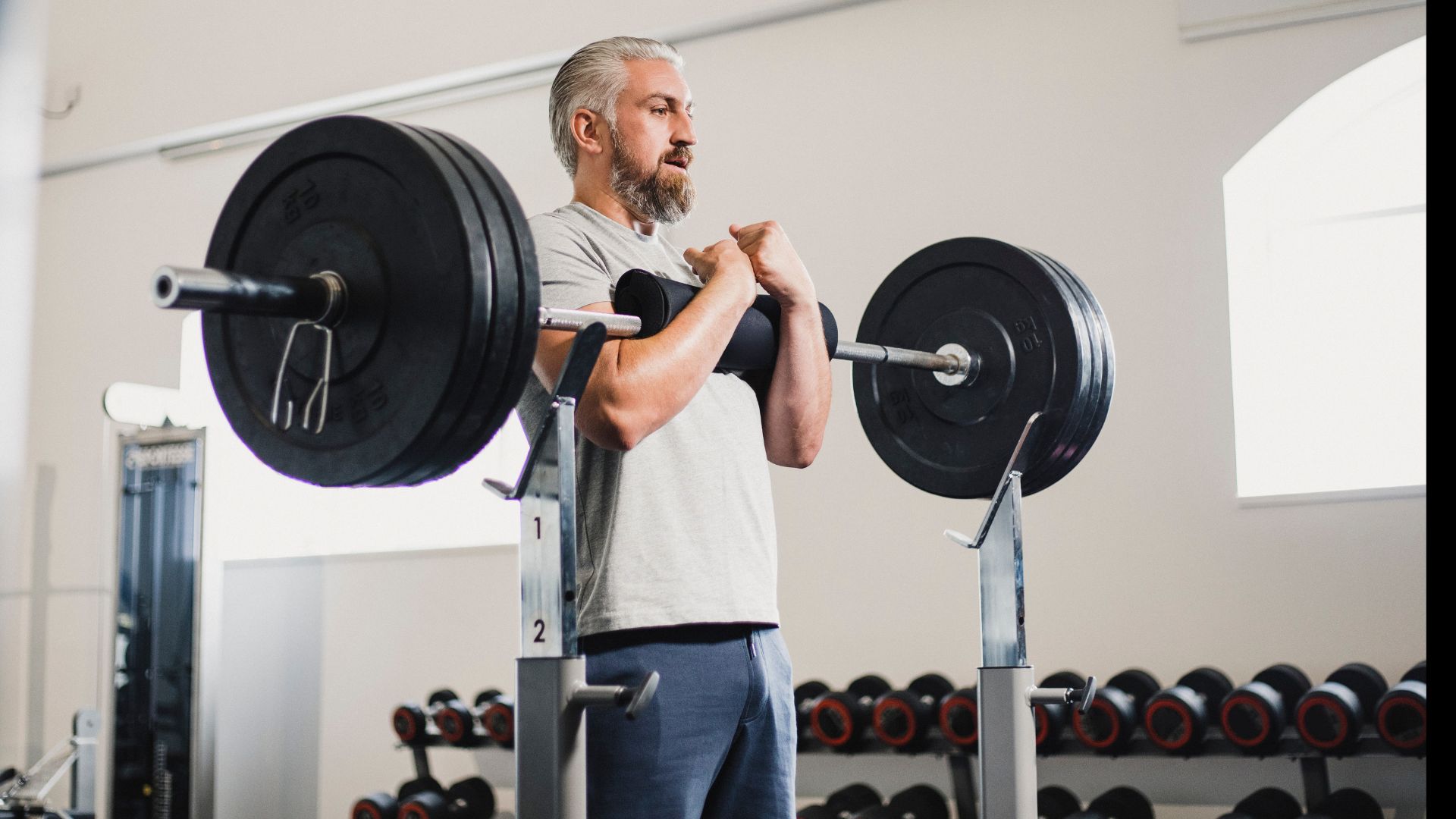Hey there, fitness enthusiasts! If you’ve ever wondered which squat grip reigns supreme when it comes to sculpting those glutes, you’re in the right place.
In this blog post, we’re diving deep into the world of squats to find out which grip gives your glutes the ultimate workout.
So, grab your workout gear and let’s get started on the quest for the perfect squat grip for those booty gains!
Understanding the best squat grip for glutes: how and why.
The best squat grip for targeting the glutes depends on your goals and individual preferences.
There are several squat variations and grips that can effectively engage the glutes.
Here are some of the most common squat grips and how they can affect your glute activation:
Back Squat with a Low Bar Grip: This grip involves placing the barbell lower on your back, resting it on the rear deltoids.
A low bar back squat tends to shift more of the emphasis onto the hips and glutes. It allows you to hinge at the hips more, which can result in greater glute activation.
Back Squat with a High Bar Grip: With this grip, the barbell is placed higher on your upper back, resting on the traps.
High bar back squats generally involve more quad engagement compared to low bar squats but can still target the glutes effectively if you focus on hip drive during the lift.
Front Squat: The front squat involves holding the barbell in front of your shoulders. While it primarily targets the quads and core, it can also engage the glutes, especially if you maintain an upright posture and push your hips back as you descend.
Goblet Squat: In a goblet squat, you hold a dumbbell or kettlebell close to your chest while performing the squat. This variation encourages an upright torso and can engage the glutes effectively when performed with proper form.
Sumo Squat: This squat variation involves a wide stance with toes pointed outward. Sumo squats put a significant emphasis on the inner thigh and glute muscles.
Holding a dumbbell or kettlebell in front of you can increase the resistance.
Bulgarian Split Squat: While not a traditional squat, this single-leg exercise can be excellent for glute activation.
Holding dumbbells in each hand or a barbell across your back can help target the glutes even more.
Smith Machine Squat: Using a Smith machine allows you to adjust the bar path to target specific muscle groups. To emphasize the glutes, you can set the bar path slightly forward and use a wider stance.
Remember that individual biomechanics and preferences play a significant role in which squat grip works best for your glutes.
It’s essential to focus on proper form, gradually increase the weight/resistance, and listen to your body to determine which squat variation and grip provide the most effective glute activation for you.
Additionally, incorporating a mix of these squat variations into your workout routine can help ensure well-rounded glute development.
Further Explanations.
Let’s delve deeper, let me explain these points mentioned further.
First Let’s break down the mechanics and benefits of the Low Bar Grip Back Squat for greater glute activation:
Back Squat with a Low Bar Grip.
Bar Placement:
In the Low Bar Grip Back Squat, the barbell is positioned lower on your back compared to the High Bar Grip Back Squat.
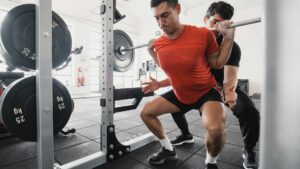
It typically rests on the rear deltoids, which are the muscle groups located just below the tops of your shoulders.
Hinging at the Hips:
With the barbell in this lower position, your torso tends to lean forward slightly as you initiate the squat movement.
This forward torso lean encourages you to hinge at the hips more, which means you’ll be tilting your upper body forward as you descend into the squat.
Greater Hip Engagement:
The hip hinge places a greater emphasis on the hip muscles, particularly the glutes and the posterior chain (lower back, hamstrings, and glutes).
This is because you are pushing your hips back and lowering your torso closer to parallel with the ground before descending further into the squat.
Increased Glute Activation:
As you push your hips back and lean forward, your glutes are engaged to a higher degree to stabilize and support the movement.
The deeper hip hinge and the angle of your torso make the glutes work harder to help you maintain balance and generate power during the lift.
Targeting the Posterior Chain:
The Low Bar Grip Back Squat is often favored by powerlifters and those looking to lift heavy weights because it allows you to use the posterior chain effectively.
This makes it an excellent choice if you want to develop strength and size in your glutes.
It’s important to note that while the Low Bar Grip Back Squat can provide significant glute activation, it also places more stress on the lower back and may require more mobility in the shoulders and wrists to maintain the correct bar placement.
Proper form, including maintaining a neutral spine and not allowing your lower back to round, is crucial when performing this squat variation to prevent injury.
In other words, the Low Bar Grip Back Squat is a squat variation that places the bar lower on your back, encourages a forward torso lean, and engages the glutes to a greater extent by emphasizing the hip hinge. This makes it an effective choice for those seeking to target and develop their glute muscles.
Back Squat with a High Bar Grip.
let’s delve into the mechanics and benefits of the High Bar Grip Back Squat and how it can target the glutes effectively:
Bar Placement:
In the High Bar Grip Back Squat, the barbell is positioned higher on your upper back, specifically on the trapezius muscles (traps). This placement is closer to the base of your neck.
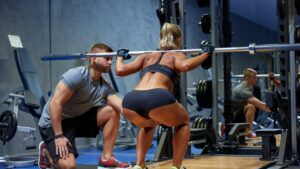
More Upright Torso Position:
Unlike the Low Bar Grip Back Squat, the High Bar Grip encourages a more upright torso position.
Your upper body remains relatively vertical as you initiate the squat, which can be advantageous for certain lifters, especially those focused on quad development.
Quad Dominance:
The High Bar Grip Back Squat places a greater emphasis on the quadriceps (front thigh muscles) compared to the Low Bar Squat.
This is because the more upright torso position allows you to push through the knees more directly, engaging the quads to a higher degree.
Glute Activation:
While the primary emphasis in the High Bar Grip Squat is on the quads, it can still target the glutes effectively.
This happens mainly during the ascent phase of the squat when you push your hips forward and straighten your hips and knees. This is where the hip drive comes into play.
Hip Drive:
To engage the glutes more in the High Bar Grip Back Squat, it’s essential to focus on hip drive.
As you ascend from the squat, consciously push your hips forward and engage your glutes to bring your body to an upright position.
This hip drive recruits the glute muscles to a greater extent, complementing the primary quad activation.
Well-Rounded Leg Development:
Incorporating High Bar Grip Back Squats into your routine can contribute to well-rounded leg development.
While it’s quad-dominant, the added glute engagement during hip drive ensures that the glutes are still trained effectively.
It’s worth noting that the High Bar Grip Back Squat is often favored by Olympic weightlifters and athletes who require a more upright position, such as when catching a clean or snatch.
The emphasis on quads and a more balanced leg development aligns well with their training needs.
Ultimately, whether you choose a High Bar or Low Bar Grip Back Squat for glute development may depend on your individual goals and body mechanics.
Some lifters may find that a combination of both variations in their training program provides the best overall leg and glute development. Proper form, as always, is critical to maximize the benefits while minimizing the risk of injury.
Front Squat
let’s explore the Front Squat and how it can engage the glutes while primarily targeting the quads and core:
Bar Placement:
In the Front Squat, the barbell is positioned in front of your shoulders, resting on the front part of your deltoids and clavicles. Your hands are positioned under the bar with your elbows pointed forward.
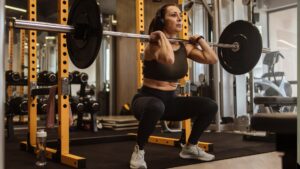
Upright Posture:
One of the key features of the Front Squat is the need to maintain an upright torso throughout the movement.
This upright posture places a significant demand on the core muscles, as they must work hard to stabilize your spine.
Quad Emphasis:
The Front Squat primarily targets the quadriceps (front thigh muscles) due to the more upright posture and the mechanics of the movement.
This squat variation requires you to bend at the knees more directly, which places a strong emphasis on the quads.
Glute Engagement:
While the Front Squat may not be the most glute-dominant squat variation, it can still engage the glutes effectively, especially if you perform the movement correctly.
To maximize glute engagement, focus on pushing your hips back as you descend into the squat.
Hinging at the Hips:
By pushing your hips back slightly and maintaining a controlled descent, you create tension in the glutes.
This hip movement mimics a hip hinge to some extent, which is a key factor in activating the glute muscles.
Balanced Leg Development:
The Front Squat can contribute to balanced leg development by targeting both the quads and glutes.
While the quads are the primary focus, the engagement of the glutes adds to the overall effectiveness of the exercise.
Core Activation:
In addition to glutes, the Front Squat places a strong emphasis on core strength.
The anterior placement of the barbell forces your core muscles to work hard to stabilize your spine and maintain an upright position.
The Front Squat is often favored by athletes, weightlifters, and bodybuilders looking to develop a strong core and well-rounded leg muscles.
Its emphasis on maintaining an upright posture, combined with the potential for glute engagement, makes it a valuable addition to a comprehensive leg training program.
To optimize glute activation in the Front Squat, ensure that you’re using proper form, maintaining an upright torso, and focusing on the hip movement as you descend and ascend.
Like any squat variation, starting with lighter weights and gradually increasing the load is advisable to build strength and maintain safety.
Goblet Squat.
Let’s delve into the Goblet Squat and how it encourages an upright posture and engages the glutes effectively when performed with proper form:
Equipment:
In a Goblet Squat, you use a dumbbell or kettlebell as resistance. You hold the weight close to your chest, usually with both hands grasping the top of the dumbbell or the sides of the kettlebell.
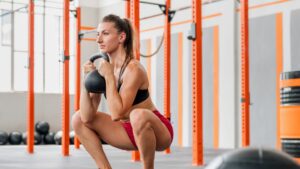
Upright Torso:
One of the standout features of the Goblet Squat is its ability to naturally promote an upright torso. The weight held close to your chest acts as a counterbalance, encouraging you to keep your upper body vertical throughout the movement.
Glute Engagement:
While the Goblet Squat primarily targets the quadriceps and core muscles, it can also engage the glutes effectively when performed with the correct technique. Here’s how:
Hip Hinge:
As you descend into the squat, you should initiate the movement by pushing your hips back and sitting back into the squat. This hip hinge movement places tension on the glute muscles.
Hip Drive:
During the ascent phase of the squat, focus on driving your hips forward and straightening your hips and knees. This hip drive engages the glutes to bring your body back to a standing position.
Core Activation:
Holding the weight close to your chest requires strong core activation to stabilize your upper body. This added core engagement complements the glute activation, creating a well-rounded lower body exercise.
Balanced Leg Development:
The Goblet Squat, with its emphasis on both an upright torso and hip engagement, contributes to balanced leg development. While it may not be as heavy as some barbell squat variations, it’s highly effective for overall leg strength and muscle development.
Accessibility:
Goblet Squats are accessible for individuals of various fitness levels because they don’t require specialized equipment like a barbell rack.
They are an excellent option for those starting their fitness journey or working out at home with limited equipment.
The Goblet Squat is often recommended as a foundational squat variation due to its focus on proper form, posture, and its versatility for a wide range of individuals.
Whether your goal is general lower body strength, glute activation, or improved squat mechanics, the Goblet Squat can be a valuable addition to your workout routine.
Remember to use proper form, maintain an upright posture, and progressively increase the weight as you become more comfortable with the exercise to continue challenging your glutes and lower body effectively.
Sumo Squat.
Certainly, let’s explore the Sumo Squat and how it emphasizes the inner thigh and glute muscles, especially when performed with added resistance:
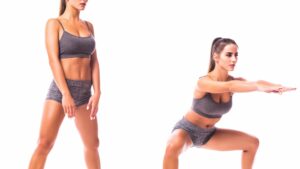
Stance and Toe Position:
In the Sumo Squat, you assume a wide stance with your feet positioned much farther apart than in a traditional squat.
Your toes are typically pointed outward at an angle, often around 45 degrees or more, resembling a sumo wrestler’s stance.
Inner Thigh Emphasis:
The wide stance and outward toe positioning in the Sumo Squat place a significant emphasis on the inner thigh muscles, known as the adductors.
As you lower your body into the squat, these muscles are engaged to help stabilize your stance and control the movement.
Glute Engagement:
While the primary focus of the Sumo Squat is on the inner thighs, it also engages the glute muscles effectively, particularly the gluteus medius and gluteus minimus.
These muscles are responsible for abduction and lateral hip movement, which are emphasized in the wide stance.
Hip Hinge:
Similar to other squat variations, the Sumo Squat involves a hip hinge as you lower your body. This hip movement recruits the glutes to support and control the descent, especially if you push your hips back and maintain an upright posture.
Added Resistance:
To increase the intensity of the Sumo Squat and further engage the glutes and inner thighs, you can hold a dumbbell or kettlebell in front of you. This added resistance challenges both your lower body and core stability.
Core Activation:
In addition to working the lower body, the Sumo Squat requires core activation to maintain proper posture and stability. Keeping the weight close to your body adds an extra layer of core engagement.
Variability:
The Sumo Squat offers variability in terms of foot positioning and resistance levels, making it suitable for individuals at different fitness levels and with various training goals. You can adjust your stance width and the weight you use to tailor the exercise to your needs.
The Sumo Squat is particularly beneficial for targeting the inner thigh and glute muscles, which may be underutilized in more traditional squat variations. It can help improve lower body strength, enhance hip mobility, and contribute to a balanced leg workout routine.
When performing Sumo Squats, ensure you maintain proper form, including keeping your chest up, knees tracking in line with your toes, and engaging your core. Start with a manageable weight, gradually increase resistance as you progress, and always prioritize safety in your training.
Bulgarian Split Squat.
let’s explore the Bulgarian Split Squat and how it can be excellent for glute activation, especially when using added resistance:

Setup:
The Bulgarian Split Squat, also known as the Bulgarian lunge or rear-foot-elevated split squat, is a single-leg exercise.
To perform it, you need a bench or a platform behind you. Stand a few feet in front of the bench with your back to it.
Execution:
Here’s how you perform the Bulgarian Split Squat:
Place one foot behind you on the bench or platform, with your toes resting on it.
The other foot remains a few feet in front of the bench.
Keep your chest upright and your core engaged.
Lower your body by bending the front knee, ensuring it doesn’t go past your toes.
Lower your body until the back knee almost touches the ground or until your front thigh is parallel to the ground.
Push through the heel of the front foot to return to the starting position.
Glute Activation:
The Bulgarian Split Squat can be excellent for glute activation due to several factors:
Single-Leg Emphasis:
Because it’s a single-leg exercise, the glutes on the working leg have to work harder to stabilize and control the movement.
Deep Range of Motion:
The exercise allows for a deep range of motion, requiring the glutes to work through a broad spectrum of movement, which can lead to effective glute activation.
Added Resistance:
Holding dumbbells in each hand or a barbell across your back can significantly increase the resistance, making it an excellent exercise for building glute strength and size.
Core Engagement:
The Bulgarian Split Squat also engages the core muscles to stabilize your body throughout the movement, contributing to overall core strength.
Balance and Coordination:
This exercise challenges your balance and coordination, which can improve your overall lower body stability and enhance glute activation.
Variability:
You can adjust the intensity of the exercise by altering the height of the bench, the weight you use, or the depth of your squat. This adaptability makes it suitable for various fitness levels.
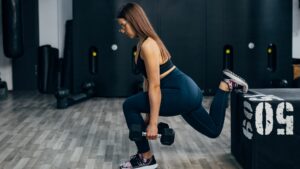
Functional Movement:
The Bulgarian Split Squat is a functional movement that mimics many real-life activities and sports. Building strong glutes with this exercise can translate to better performance in daily activities and athletic endeavors.
Incorporating Bulgarian Split Squats into your workout routine can be an effective way to target and strengthen your glutes, improve lower body stability, and enhance overall leg development. When performing the exercise, maintain proper form, ensure your front knee doesn’t go past your toes, and gradually increase the weight as you progress to continue challenging your glutes effectively.
Smith Machine Squat.
let’s explore how the Smith Machine Squat can be used to emphasize the glutes by adjusting the bar path and stance:
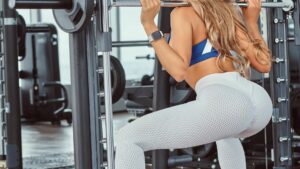
Smith Machine Benefits:
The Smith machine is a versatile piece of gym equipment that provides a guided bar path, which can be advantageous for targeting specific muscle groups and controlling movement.
Bar Path Adjustment:
The key advantage of the Smith machine is the ability to adjust the bar path to focus on particular muscle groups. To emphasize the glutes, you can make the following adjustments:
Slightly Forward Bar Path:
Begin by positioning the bar slightly forward of your body, so it’s not directly over your shoulders but rather in front of them.
This slight forward placement can encourage a hip hinge movement, which is crucial for engaging the glutes.
Wider Stance:
Use a wider stance than you would in a traditional squat. A wider stance allows you to recruit the glutes more effectively, as it requires greater hip abduction and external rotation, both of which engage the glutes.
Glute Emphasis:
By setting the bar path slightly forward and adopting a wider stance, you’re placing a greater emphasis on the glute muscles. This allows for more hip engagement during the squat.
Quadriceps and Hamstrings:
While the emphasis is on the glutes, the Smith Machine Squat still engages the quadriceps and hamstrings. However, the adjustments in bar path and stance help shift more of the load onto the glutes.
Safety and Stability:
The guided bar path in the Smith machine can provide a level of safety and stability, which can be beneficial when targeting the glutes with heavy weights, especially for those with lower back concerns or mobility limitations.
Progressive Overload:
Like other squat variations, it’s essential to progressively increase the weight over time to continue challenging the glutes and promoting muscle growth.
Variation:
The Smith Machine Squat is just one of many squat variations available, and it can be used in combination with other squats to create a well-rounded lower body workout routine.
While the Smith Machine Squat can be a valuable tool for targeting the glutes when used with the proper adjustments, it’s essential to maintain good form, including keeping your back straight and your knees tracking over your toes.
Additionally, incorporating other glute-focused exercises into your routine, such as lunges, deadlifts, or hip thrusts, can help ensure comprehensive glute development.
A tabular includes the ratios.
Here I provide a general overview of how various squat grips can affect glute engagement without specifying exact ratios.
| Squat Grip | Glute Engagement | Additional Muscle Activation | Notes |
|---|---|---|---|
| Low Bar Back Squat | Moderate-High | Hamstrings, Lower Back | Emphasizes hip hinge and posterior chain. |
| High Bar Back Squat | Moderate | Quadriceps, Core | More upright posture, still engages glutes. |
| Front Squat | Moderate | Quadriceps, Core | Emphasizes core and upright posture. |
| Goblet Squat | Moderate | Core | Encourages upright posture, engages glutes. |
| Sumo Squat | Moderate-High | Inner Thighs, Adductors | Wide stance targets inner thighs and glutes. |
| Bulgarian Split Squat | Moderate-High | Quadriceps, Hamstrings, Core | Single-leg exercise, engages glutes well. |
| Smith Machine Squat | Moderate-High | Quadriceps, Hamstrings, Core | Bar path and stance adjustments can help. |
Please note that individual preferences, biomechanics, and training goals play a significant role in determining which squat grip is best for targeting the glutes.
It’s essential to focus on proper form, gradually increase resistance, and listen to your body to determine which squat variation works best for your glute development.
Additionally, the ratios mentioned in the table are generalized and based on typical muscle activation patterns for each squat variation.
Actual muscle engagement can vary widely based on factors like body mechanics, squat depth, and form.
Conclusion.
In summary, when it comes to the best squat grip for targeting the glutes, the Low Bar Back Squat grip is often favored.
This grip encourages a hip hinge movement and places more emphasis on the posterior chain, making it an effective choice for those looking to develop and strengthen their glute muscles.
However, it’s essential to remember that individual preferences and biomechanics play a role, so it’s a good idea to explore different squat variations to find the one that works best for your specific goals and body mechanics.

Hey there, it’s Mike Rrsq, the Editor-in-Chief over at Jsquat.com, and I’m absolutely obsessed with all things squat fitness! I’ve been lucky enough to get some serious recognition for my work in this field. With a solid background in the fitness and wellness industry, I’ve been there right from the get-go, helping shape this website into what it is today.
You see, I’m not just the boss around here; I’m also a passionate contributor. I love sharing my insights through my articles, and trust me, they’re not your run-of-the-mill stuff. Each piece I write is a labor of love, filled with my expertise and real-world experience in the fitness universe. So, if you’re into fitness and looking for some inspiration, you’re in the right place!

